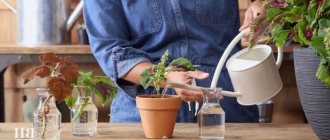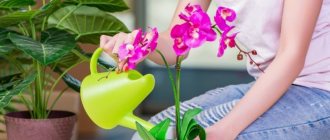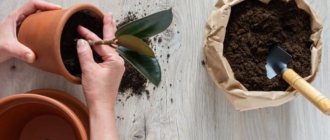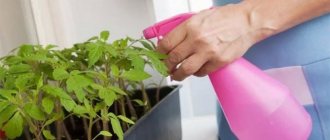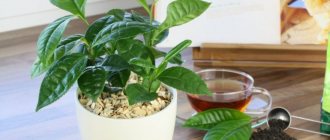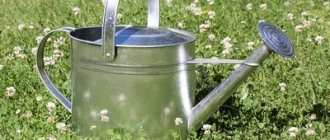The importance of water for plants cannot be overstated. This is the main component in the composition of flowers. Water nourishes with mineral salts coming through the root system from the soil, which allows for the active development of the root system and the growth of green mass. Therefore, watering is one of the most important plant care procedures. There are no exact universal recommendations on how often indoor flowers should be watered, since the amount depends on many factors, such as individual characteristics, location, time of year, etc. This article will help you figure out how to water flowers correctly and how to eliminate mistakes that have already been made.
How often to water house plants
Due to the fact that there are plenty of factors influencing the frequency and abundance of hydration, an individual approach is required for each flower. However, there are general recommendations that tell you how to water your house flowers:
- material used in making a pot. Representatives of the same species growing in pots made of clay and plastic need to be watered differently. The first will require more moisture than the second, since the water in it also leaves through the porous walls;
- The size of the pot also plays a role. Obviously, a large pot will require more water than a small one;
Watering indoor flowers
- location of the bush. Watering indoor plants located on the south side should be more intensive, especially during the warm period;
- air temperature. Plants located in a warm room need to be watered more often and more intensively than those located in a cool room. By following this rule, you can avoid drying out the soil or rotting the roots;
- the weather, which also determines how often indoor flowers need to be watered. In hot weather, the amount of water should be increased and vice versa.
Important! In everything you need to know when to stop. And in the heat, you should not water the flower garden too intensively; this should be done only as needed. And most importantly, you need to focus on the type and botanical group of the indoor flower.
How to water a money tree after replanting
The need to replant a money tree arises when the roots of the plant become so long and branched that they entwine the entire earthen lump in the pot. Such plants are moved to a larger diameter vessel. Young crassulas should be planted in a new location every year, and older plants should be planted once every three to four years. You should not make a common mistake for beginning plant growers - immediately plant a young flower in a large pot. Indeed, in such a container after each watering, moisture will accumulate due to slow drying, which will significantly increase the risk of rotting of the root system and death of the plant. Transplantation is best done in the spring, when active sap flow in the tree resumes.
It is important to follow the step-by-step watering schedule after transplanting the fat plant. The main rule is that it is better to give less moisture than to transfer it
Something to remember! The money tree easily copes with drought, while waterlogging can destroy it.
After transplantation, watering is carried out in two ways:
- In case of emergency resuscitation (for example, after flooding) and damaged roots drying out in air, the plant should be watered very little and immediately after placing the rhizomes in the substrate;
- When planning a transplant, be sure to water the new “tenant” after a day or two. In this case, the soil mixture will settle a little; it should be filled to the required level and watered again (avoiding stagnation of water in the pan).
It is necessary to water after transplanting within a day or two.
Many houses have a Crassula money tree on their window. It is believed to bring good luck and financial well-being. In general, this plant is unpretentious; the main thing is to water it correctly and maintain the temperature regime. The number of waterings varies depending on the season: in the hot summer it is a couple of times a week, in the winter when the flower goes into hibernation, once a month is enough. If these conditions are met, the tree will delight its owners with lush “fleshy” foliage in the form of coins.
Watering indoor plants in spring, summer, autumn and winter
DIY drip irrigation for indoor plants
There are several main periods: active growth and vegetation (spring-autumn), flowering period (most often in summer) and dormant period (winter). Caring for flowers in each of them should be different from the previous one so that they give lush, lush greenery and bright blooms.
How often to water indoor flowers in winter is not always easy to understand. Firstly, each flower has its own time frame for this period, for some it does not occur at all. Secondly, each individual species needs individual conditions. The frequency of soil irrigation depends on these parameters.
In winter, daylight hours are reduced, and many plants also need to reduce the air temperature in order to properly rest. If you manage to do this, then watering should be done rarely, as the soil dries out. Some species (for example, begonia) take a break from water altogether in winter. But, if it was not possible to ensure a low temperature, then watering should be reduced. Most often it is produced 2-3 times less often than in summer.
Indoor flowers during the dormant period
By spring, plants gradually awaken from winter sleep, move into a new phase and should be provided with proper watering. It becomes more frequent and intense. Summer, especially hot summer, is the period of the most abundant and frequent soil moisture. By autumn everything gradually decreases again.
Important! If the summer turns out to be cold and rainy, you should not be overzealous with the amount of water, this can cause rotting of the roots, especially in sensitive flowers. Because of this, they may die.
Irrigation nuances
Special watering conditions are provided during certain periods of the plant’s life.
After transplant
After replanting, watering is carried out at the slightest sign of drying of the top layer of soil.
It is undesirable to moisten young plants in the evening, since the roots are not yet sufficiently developed, some of the moisture will remain in the pot, causing rot and bacterial damage.
After feeding
Feeding is carried out in the following sequence:
- Water the plant moderately. This will moisten the soil and allow the roots to absorb some water. After fertilizing, the plant will gradually consume nutrients, which will prevent chemical burns.
- After 2–3 hours, fertilizers are applied, preferably water-soluble in the proportions specified by the manufacturer.
- After a dry crust has formed, water the plant moderately again.
In the future, they switch to the usual and usual mode of adding moisture.
During the flowering period
During flowering, the plant actively uses water for the growth of flowering shoots and the flowers themselves.
At this time, the intervals between waterings are reduced, and the amount of water with each application is increased .
The specific time of day is chosen based on the established schedule to which the plant and grower are accustomed.
When to water indoor flowers: time of day to water houseplants
Watering indoor plants in the absence of owners for 2 weeks or a month
The ideal time of day for watering is morning. This has been known for a long time and has been scientifically proven. After all, during the day the moisture has time to evaporate, and watering in the evening leads to the opposite result. Excess liquid can accumulate at the roots, which will not lead to anything good. Due to increased dampness, fungal infections can develop, and the underground part of the plant will no longer receive the necessary oxygen.
For your information! It's sad but true: more plants die from improper watering than from all other factors combined.
Is it possible to leave water in the pan?
When top watering house plants, part of the water often ends up in the tray. Some consider this excess moisture that needs to be drained so that the flower does not turn sour. But it is not so! After all, the soil is sometimes not able to absorb all the incoming water at once. For example, if the substrate is dry enough, some of the water may pass through, but after a while the earth will “draw in” the “unfinished” water. This ensures complete watering! In addition, if there is drainage at the bottom of the pot, it will protect the soil from souring.
However, everything is individual! So, for succulents, a lot of excess moisture in a pot may not be desirable, because their roots prefer to be in conditions of moderate humidity. Therefore, it is worth checking the pan after half an hour - if the water has not been absorbed, it is better to drain it. For moisture-loving plants - nephrolepis, hoya, palm trees, many decorative deciduous plants, moisture in the tray is not at all dangerous, but even beneficial.
Factors influencing the irrigation regime
Fertilizers for indoor plants: varieties and feeding rules
How to properly water home flowers depends on a number of factors. More moisture will be required:
- in a phase of active growth and development;
- when placed in a large flowerpot or made of natural material;
- if the plant has large thin leaves;
- with a pronounced, good, powerful root system;
- at high air temperatures in the warm season;
- at low air humidity;
- with constant ventilation of the room.
Less intensive watering is required:
- in pots where the soil is not particularly loose;
- plants with thick, fleshy leaves or without leaves;
- flowers that have only recently been transplanted from another pot, weak and painful;
- owners of a short root;
- in the phase of slow growth or dormancy;
- in the absence of a drainage layer;
- in low temperature conditions;
- at high air humidity.
Is it possible to spray a money tree?
In addition to watering the root system area directly, many indoor plants (for example, spathiphyllum, tradescantia, chlorophytum, etc.) require cleaning the leaves from dust and humidifying the air near them by spraying from a spray bottle.
The money tree is not so picky; it is not at all necessary to spray it regularly. However, if the room is too hot or the air is dry, you can spray the plant a little with a spray bottle of simple settled (or better melt) water in the absence of direct sunlight.
Note! When spraying, it is advisable to cover the soil in the root zone and the trunk circle with a piece of polyethylene so that moisture does not penetrate into the substrate and lead to unnecessary wetting.
Sometimes you can spray the foliage of the Crassula with a spray bottle.
The coin-shaped leaves can be periodically wiped from accumulating dust with a damp cloth. It is also necessary to ensure proper air flow, i.e. ventilate the room where the pot of Crassula is located.
How to water flowers correctly
There are two main ways to water plants - top and bottom. You should choose one method or another based on the type of plant and general recommendations. In any case, you need to water the flowers only with water at room temperature; cold water is stressful for them. Rain or melt water is best; if this is not available, you can water it with settled tap water, but not boiled water, since the boiling process kills all the necessary microelements.
Which is better - top or bottom watering?
The overhead irrigation method is the most common and traditional. With constant watering from above, the soil in the pot is completely and more evenly saturated with moisture, and the plant feels as comfortable as possible. It is worth remembering that you need to water, evenly distributing the moisture over the surface, otherwise grooves will form and the roots may be exposed. Violets, succulents, and indoor banana trees love this type of irrigation the most.
Watering flowers from above
There are times when you can't allow moisture to get on the leaves of your plants, or when they may be sending roots outside the pot. For such plants, the best option is bottom watering. Water is poured into the pan of the pot, and the moisture is absorbed on its own in the amount needed. This is how you need to water Saintpaulias, soleirolias, azaleas, and begonias.
Important! Bottom watering can cause all minerals to rise to the top and even form a white layer on the surface of the soil. In this case, it is necessary to restore the balance using the top moisture supply.
Bottom watering of flowers
Volume of liquid when watering
Depending on the plant’s genus, it needs a certain watering regime, according to which the volume of liquid required is determined:
- abundant. This is done immediately after the soil in the pot has dried. This option is required for almost all tropical bushes, plants with thin, long leaves, and large specimens;
- moderate. It is not done immediately, but after a couple of days. It is needed by flowers with pubescent leaves or stems (for example, violets), thick woody roots (ficus);
- infrequent watering is suitable for cacti and other succulents. With this, the earthen lump can remain dry for up to several weeks.
What time of day - morning or evening?
Watering in the morning is preferable at almost any time of the year:
- in the summer, so that the substrate does not dry out in a day, and the leaves do not wither from excessive evaporation;
- on south windows at any time;
- in winter, so that the plants have time to absorb moisture during the daylight hours, and the roots do not become overcooled at night from excess moisture;
- in spring and autumn, when temperature changes in the room are possible: excess moisture evaporates, condensation settles on the leaves, which provokes bacterial diseases; at low temperatures, rot may occur on the surface of the soil around the flower.
Daytime watering is desirable for plants with large leaves, as well as flowers native to the subtropics. Varieties of such flowers, bred artificially, retain the need for daytime moisture. Most often, at this time, the leaves are sprayed or wiped to prevent wilting.
Evening watering is recommended as additional watering in dry microclimates. In cases where the gardener decides to water the flowers for some reason, lighting should be provided for 2-3 hours after the procedure. This will allow the plants to absorb excess moisture from the substrate before going dormant at night.
Improper watering: signs and their elimination
If you systematically violate the watering rules required for a particular flower, you can get undesirable consequences, in particular, its death.
Is it possible to revive a dried out houseplant?
If the soil is completely dry, it begins to refuse to accept moisture. Regardless of the amount of water poured, only the upper part of the soil is wetted. This occurs due to the fact that the dried soil decreases in size and lags behind the walls of the pot, forming cracks into which moisture flows and exits through the drainage hole.
To save the situation, you need to water the plant in the shower, then place it in a basin filled with water and wait until the earthen lump is completely wet (all air bubbles should come out of it). Then remove the pot and wait for the excess water to drain. Not all plants are able to withstand a long absence of moisture, but if it succeeds, it will soon turn green again.
Note! It is also important to remember about the gaps that have formed between the soil and the walls of the pot. They need to be filled with fresh soil.
What to do if the flower is flooded
If a florist is faced with the opposite problem, then it is worth remembering that this is as dangerous as drought. But you can save the flower. To do this, you need to carefully remove it from the pot, remove any rotten and weak roots that have appeared and wrap it with an absorbent cloth or waffle towel. If the towel is completely soaked, you should immediately change it to a dry one. Then you need to wrap the lump in paper towels and leave until completely dry. After this, the plant should be planted in a new container filled with fresh soil mixture.
What types of irrigation exist
Based on the purpose they serve, irrigation is divided into the following types:
- moisture charging is carried out in order to create a supply of moisture in the soil. This may be moistening the bed before planting seedlings or before filling containers with soil for planting;
- post-sowing (or pre-sowing) - moisten the soil to the depth of the seeds;
- refreshing is carried out in hot weather using a sprayer. It is also called sprinkling;
- fertilizing - for adding dissolved and liquid fertilizers to the soil;
- anti-frost - in early spring or late autumn, complete wetting of the foliage is carried out;
- Vegetative irrigation is the main type of irrigation that nourishes plants as they grow. The moisture depth should be at least 40 cm.
Watering cabbage
According to the method of irrigation, they are also divided into types: manual or machine sprinkling, overhead irrigation (under the root), underground, spraying.
Note! Water application rates vary depending on the growing period, soil type and climatic conditions.
Drip irrigation is designed to supply moisture to the plants constantly and in doses. Its equipment will take time and require certain expenses, but it will free you from the need to carry a heavy watering hose and will give you the opportunity to do other things while watering.
Drip irrigation systems are commercially available, or you can make them yourself. Advantages of drip irrigation:
- water comes directly to the root of the plant;
- You can add fertilizer along with moisture;
- constant maintenance of soil moisture;
- you can select the desired mode.
Disadvantages include monetary costs for pipes, pump and fittings.
The simplest option for drip irrigation is to use plastic bottles with holes made in them, through which water gradually flows to the stem.
Drip irrigation
What determines a plant’s need for moisture: soil moisture indicators
Flower shops offer a variety of soil moisture meters for indoor plants. The main advantage of such indicators is that, thanks to special sensors, they demonstrate not only the water level in the entire pot, but also its amount specifically at the roots of the plant. Such measurements are especially important for fastidious, high-maintenance plants, for which the liquid level must always be at a certain level: you cannot overdo it or overdry it.
Soil moisture indicator
To care for indoor flowers, you need to feed them in a timely manner, take care of the level of lighting, temperature and air humidity. However, without proper regular watering nothing will work. This is worth taking care of even when the whole family is leaving somewhere and there is no one to water the flowers. For such situations, a special device is suitable, sold in stores and providing automatic watering. It is worth providing the flowers with the necessary care, and they will delight you with their chic appearance and bright, lush blooms.
How to irrigate using the immersion method?
This is the so-called bottom watering, in which a flower pot is immersed in a container of water and remains there until the soil absorbs a sufficient amount of moisture. The water level should not reach the edge of the pot; it is quite enough if it is in the middle of the height of the flower pot.
How to leave a flower in a container with water for a long time? There is no need to wait for the soil in the pot to absorb all the water; it still won’t absorb more than the flower needs. Usually half an hour is enough for the flower to get drunk. Excess moisture will flow into the pan; in this case, it is advisable to drain it so as not to cause acidification of the soil at the bottom of the flower pot.
